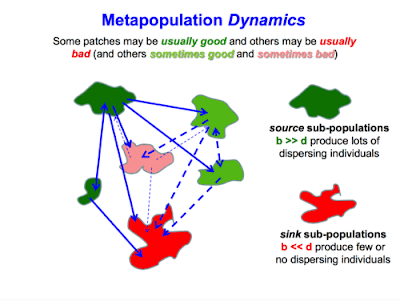Lotka-Volterra equations in Ecology
 |
| Lotka-Volterra equation |
The effects of species interactions on the population dynamics of the species involved can be predicted by a pair of linked equations that were developed independently during the 1920s by American mathematician and physical scientist Alfred J. Lotka and Italian physicist Vito Volterra. Today the Lotka-Volterra equations are often used to assess the potential benefits or demise of one species involved in competition with another species:
dN1/dt = r1N1(1 – N1/K1 – α1,2N2/K2)dN2/dt = r2N2(1 – N2/K2 – α2,1N1/K1)
Here r = rate of increase, N = population size, and K = carrying capacity of any given species. In the first equation, the change in population size of species 1 over a specific period of time (dN1/dt) is determined by its own population dynamics in the absence of species 2 (r1N1[1 – N1/K1]) as well as by its interaction with species 2 (α1,2N2/K2). As the formula implies, the effect of species 2 on species 1 (α1,2) in turn is determined by the population size and carrying capacity of species 2 (N2 and K2).
 |
| Lotka-Volterra equation |
The possible outcomes of interactions between two species are predicted on the basis of the relative strengths of self-regulation versus the species interaction term. For instance, species 2 will drive species 1 to local extinction if the term α1,2N2/K2 exceeds the term r1N1(1 − N1/K1)—though the term α1,2N2/K2 will exert a decreasing influence over the growth rate of species 1 as α1,2N2/K2 diminishes. Consequently, the first equation represents the amount by which the growth rate of species 1 over a specific time period will be reduced by its interaction with species 2. In the second equation, the obverse applies to the dynamics of species 2.
In the case of interspecific competition, if the effects of both species on each other are approximately equivalent with respect to the strength of self-regulation in each species, the populations of both species may stabilize; however, one species may gradually exclude the other over time. The competitive exclusion scenario is dependent on the initial population size of each species. For instance, when the interspecific effects of each species upon the abundance of its competitor are approximately equal, the species with the higher initial abundance is likely to drive the species with a lower initial abundance to exclusion.
 |
| Lotka-Volterra equation |
The basic equations given above, describing the dynamics deriving from an interaction between two competitors, have undergone several modifications. Chief among these modifications is the development of a subset of Lotka-Volterra equations that calculate the effects of interacting predator and prey populations. In their simplest forms, these modified equations bear a strong resemblance to the equations above, which are used to assess competition between two species:
dNprey/dt = rprey × Nprey(1 − Nprey/Kprey – αprey, pred × Npred/Kpred)dNpred/dt = rpred × Npred(1 − Npred/Kpred + αpred, prey × Nprey/Kprey)
 |
| Lotka-Volterra equation |
Here the terms Npred and Kpred denote the size of the predator population and its carrying capacity. Similarly, the population size and carrying capacity of the prey species are denoted by the terms Nprey and Kprey, respectively. The coefficient αprey, pred represents the reduction in the growth rate of prey species due to its interaction with the predator, whereas αpred, prey represents the increase in growth rate of the predator population due to its interaction with prey population.
Several additional modifications to the Lotka-Volterra equations are possible, many of which have focused on the incorporation of influences of spatial refugia (predator-free areas) from predation on prey dynamics.






